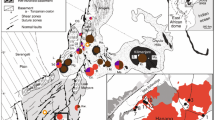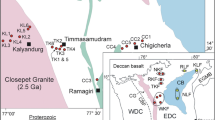Abstract
Kilauea Iki lava lake formed during the 1959 summit eruption, one of the most picritic eruptions of Kilauea Volcano in the twentieth century. Since 1959 the 110 to 122 m thick lake has cooled slowly, developing steadily thickening upper and lower crusts, with a lens of more molten lava in between. Recent coring dates, with maximum depths reached in the center of the lake, are: 1967 (26.5 m). 1975 (44.2 m), 1976 (46.0 m) and 1979 (52.7 m). These depths define the base of the upper crust at the time of drilling.
The bulk of the core consists of a gray, olivine-phyric basalt matrix, which locally contains coarser-grained diabasic segregation veins. The most important megascopic variation in the matrix rock is its variation in olivine content. The upper 15 m of crust is very olivine-rich. Abundance and average size of olivine decrease irregularly downward to 23 m; between 23 and 40 m the rock contains 5–10% of small olivine phenocrysts. Below 40 m. olivine content and average grainsize rise sharply. Olivine contents remain high (20–45%, by volume) throughout the lower crust, except for a narrow (< 6 m) olivine depleted zone near the basalt contact.
Petrographically the olivine phenocrysts in Kilauea Iki can be divided into two types. Type 1 phenocrysts are large (1–12 mm long), with irregular blocky outlines, and often contain kink bands. Type 2 crystals are relatively small (0.5–2 mm in length), euhedral and undeformed. The variations in olivine content of the matrix rock are almost entirely variations in the amount of type 1 olivines.
Sharp mineral layering of any sort is rare in Kilauea Iki. However, the depth range 41–52 m is marked by the frequent occurrence of steeply dipping (70°–90°) bands or bodies of slightly vuggy olivine-rich rock locally capped with a small cupola of segregation-vein material. In thin section there is clear evidence for relative movement of melt and crystals within these structures.
The segregation veins occur only in the upper crust. The most widely distributed (occurring from 4.5–59.4 m) are thin veins (most < 5 cm thick), which cut the core at moderate angles and appear to have been derived from the immediately adjacent wall-rock by filter pressing. There is also a series of thicker (0.1–1.5 m) segregation veins, which recur every 2–3 m, between 20 and 52 m. These have subhorizontal contacts and appear, from similarities in thickness and spacing, to correlate between drill holes as much as 100 m apart. These large veins are not derived from the adjacent wallrock: their mechanism of formation is still problematical. The total thickness of segregation veins in Kilauea Iki is 3–6 m in the central part of the lake, corresponding to 6–11% of the upper crust.
Whole-rock compositions for Kilauea Iki fall into two groups: the matrix rock ranges from 20-7.5% MgO, while the segregation veins all contain between 6.0 and 4.5% MgO. There are no whole-rock compositions of intermediate MgO content. Samples from < 12 m show eruption-controlled chemistry. Below that depth, matrix rock compositions have higher Al2O3, TiO2 and alkalies, and lower CaO and FeO, at a given MgO content than do the eruption pumices. The probable causes of this are assimilation of low-melting components from foundered crust, plus removal of olivine, plus removal of minor augite, for rocks with MgO contents of < 8.0%.
Given the observed rate of growth of the upper crust, one can infer that significant removal of the type 1 olivine phenocrysts from the upper part of the lake began in 1963 and ceased sometime prior to 1972. The process. probably gravitative settling, appears to have been inhibited earlier by gas streaming from the lower part of the lens of melt. The olivine cumulate zone, which extends into the upper crust, contains relatively few (25–40%) olivine crystals, few of which actually touch each other. The diffuseness of the cumulate zone raises the possibility that the crystals were coated with a relatively visous boundary layer of melt which moved with them. Calculations of the Stokes’ law settling rates of the largest olivine crystals found at the base of the crust in 1975–76 suggest that the «melt» had a viscosity of > 106 poises, and probably had the properties of a Bingham body, rather than a Newtonian fluid, by that date, which was several years after olivine removal ceased.
Similar content being viewed by others
References
Aki, K., Chouet, B., Fehler, M., Zandt, G., Koyanagi, R., Colp, J., andHay, R.G., 1978,Seismic Properties of a Shallow Magma Reservoir in Kilauea Iki by Active and Passive Experiments. J. Geoph. Res.,83, p. 2273–2282.
Ault, W.U., Eaton, J.P. andRichter, D.H., 1961,Lava Temperatures in the 1959 Eruption and Cooling Lava. Geol. Soc. Am. Bull.,72, p. 791–794.
—————, andStewart, D.B., 1962,A Temperature Measurement Probe into the Melt of the Kilauea Iki Lava Lake in Hawaii. J. Geoph. Res.,67, p. 2809–2812.
Chen, C.F. andTurner, J.S., 1980,Crystallization in a Double-Diffusive System. J. Geoph. Res.85, pp. 2573–2593.
Flanigan, V.J. andZablocki, C.J., 1977,Mapping the Lateral Boundaries of a Cooling Basaltic Lava Lake, Kilauea Iki, Hawaii. U.S. Geol. Survey Open-File report 77–94.
Helz, R.T., 1979,Kilauea Iki Lava Lake: Results of Coring the Upper Crust, 1967–1976. (Abstract) InHawaii Symposium on Intraplate Volcanism and Submarine Volcanism, Hilo, Hawaii, July 16–22, 1979, p. 145.
Jackson, E.D., 1961,Primary Texture and Mineral Associatiations in the Ultramafic Zone of the Stillwater Complex, Montana. U.S. Geol. Survey Prof. Paper 358, 106 pp.
Johnson, G.R., 1980,Porosity and Density of Kilauea Volcano Basalts, Hawaii. U.S. Geol. Survey Prof. Paper 1123-B, pp. 1–6.
McBirney, A.R. andNoyes, R.M., 1979,Crystallization and Layering of the Skaergaard Intrusion. J. Petrol.,20, pp. 487–554.
Moore, J.G., andEvans, B.W., 1967,The Role of Olivine in the Crystallization of the Prehistoric Makaopuhi Tholeiitic Lava Lake, Hawaii. Contr. Mineral. and Petrol.,15, pp. 202–223.
Murata, K.J., andRichter, D.H., 1966,Chemistry of the Lavas of the 1959–60 Eruption of Kilauea Volcano, Hawaii. U.S. Geol. Survey Prof. Paper 537-A, 26 pp.
Peck, D.L., 1978,Cooling and Vesiculation of Alae Lava Lake, Hawaii. U.S. Geol. Survey Prof. Paper 935-B, 59 pp.
—————, andShaw, H.R., 1977,Numerical Analysis of Lava Lake Cooling Models: Part II, Application to Alae Lava Lake, Hawaii, Am. Jour. Sci.,227, pp. 415–437.
Richter, D.H., andMoore, J.G., 1966,Petrology of the Kilauea Iki Lava Lake, Hawaii. U.S. Geol. Survey Prof. Paper 537-B, 26 pp.
----- andMurata, K.J., 1966,Petrography of the Lavas of the 1959–60 Eruption of Kilauea Volcano, Hawaii. U.S. Geol. Survey Prof. Paper 537-D, 12 pp.
-----,Eaton, J.P., Murata, K.J., Ault, W.U., andKrivoy, H.L., 1970,Chronological Narrative of the 1959–60 Eruption of Kilauea Volcano, Hawaii. U.S. Geol. Survey Prof. Paper 537-E, 73 pp.
Ryan, M.P., 1978,High Temperature Mechanical Properties of Basalt. The Pennsylvania State University, unpublished Ph.D. thesis, 391 pp.
Shaw, H.R., Peck, D.L., Wright, T.L. andOkamura, R., 1968,The Viscosity of Basaltic Magma: An Analysis of Field Measurements in Makaopuhi Lava Lake, Hawaii. Am. Jour. Sci.,266, p. 225–264.
Smith, B.D., Zablocki, C.J., Frischknecht, F.C. andFlanigan, V.J., 1977,Summary of Results from Electromagnetic and Galvanic Soudings on Kilauea Iki Lava Lake, Hawaii. U.S. Geol. Survey Open-File Report 77–59.
-----, -----, -----, andJackson, D.B., 1979,Results from Electrical Studies of Kilauea Iki Lava Lake. (Abstract). InHawaii Symposium on Intraplate Volcanism and Submarine Volcanism, Hilo, Hawaii, July 16–22, 1979, p. 151.
Wager, L.R., andBrown, G.M., 1967,Layered Igneous Rocks. Edinburgh and London, Oliver and Boyd, 588 pp.
Wright, T.L., 1973,Magma Mixing as Illustrated by the 1959 Eruption, Kilauea Volcano, Hawaii. Geol. Soc. Am. Bull.,84, p. 849–858.
————— andFiske, R.S., 1971,Origin of the Differentiated and Hybrid Lavas of Kilauea Volcano, Hawaii. J. Petrol.,12, p. 1–65.
————— andShaw, H.R., 1976,Kilauea Lava Lakes: Natural Laboratories for Study of Cooling, Crystallization and Differentiation of Basaltic Magma. InThe Geophysics of the Pacific Ocean Basin and Its Margin, A.G.U. Geophysical Monograph,19, p. 375–392.
----- andOkamura, R., 1977,Cooling and Crystallization of Tholeiitic Basalt, 1965 Makaopuhi Lava Lake, Hawaii. U.S. Geol. Survey Prof. Paper 1004, 78 pp.
----- andPeck, D.L., 1978,Crystallization and Differentiation History of the Alae Magma, Alae Lava Lake, Hawaii. U.S. Geol. Survey Prof. Paper 935-C, 20 pp.
Zablocki, C.J., andTilling, R.I., 1976,Field Measurements of Apparent Curie Temperatures in a Cooling Basaltic Lava Lake, Kilauea Iki, Hawaii. Geophys. Res. Lett.,3, p. 487–490.
Author information
Authors and Affiliations
Rights and permissions
About this article
Cite this article
Helz, R.T. Crystallization history of Kilauea Iki lava lake as seen in drill core recovered in 1967–1979. Bull Volcanol 43, 675–701 (1980). https://doi.org/10.1007/BF02600365
Issue Date:
DOI: https://doi.org/10.1007/BF02600365




